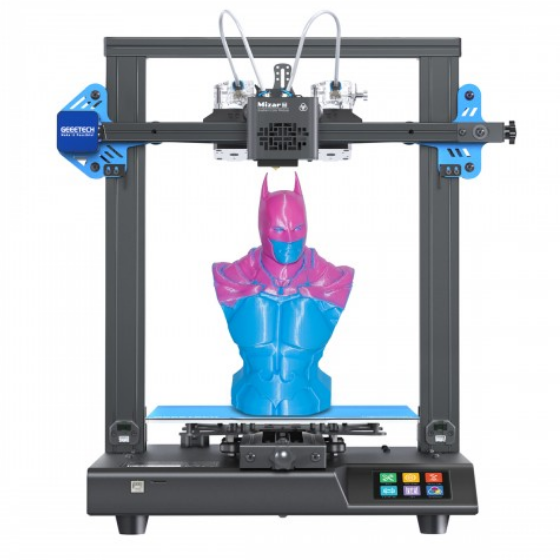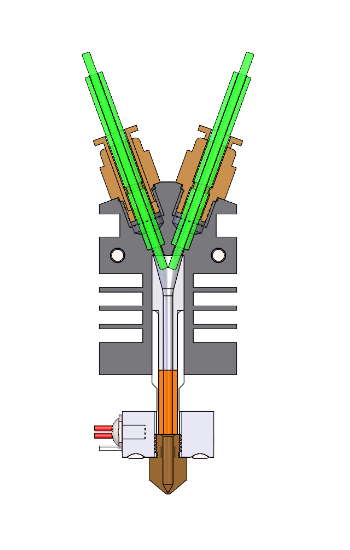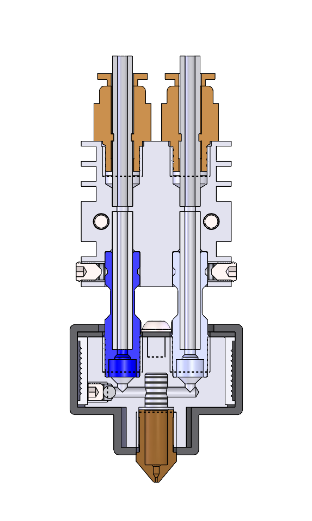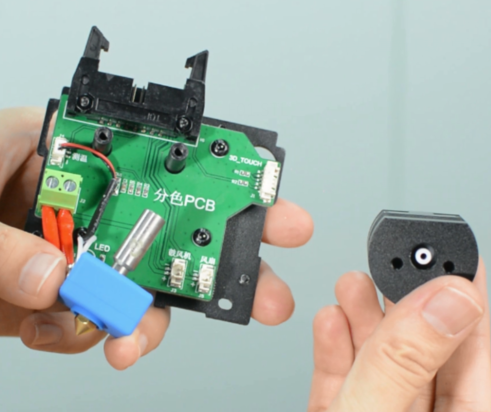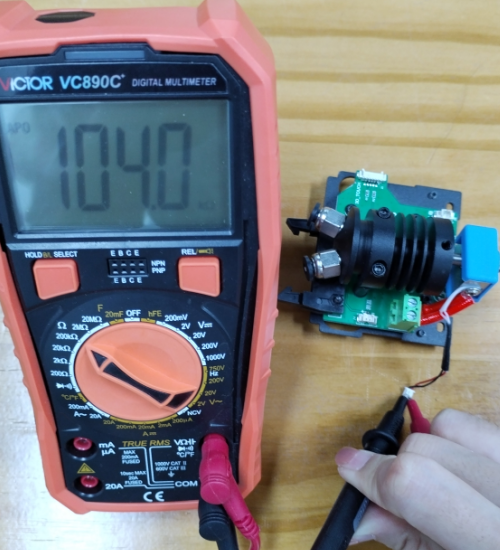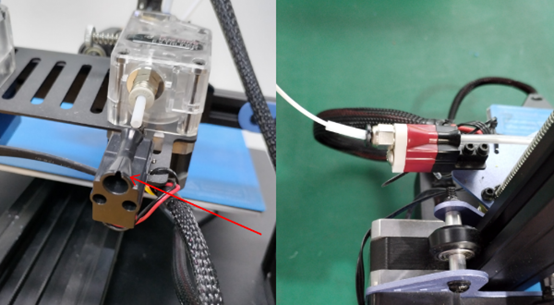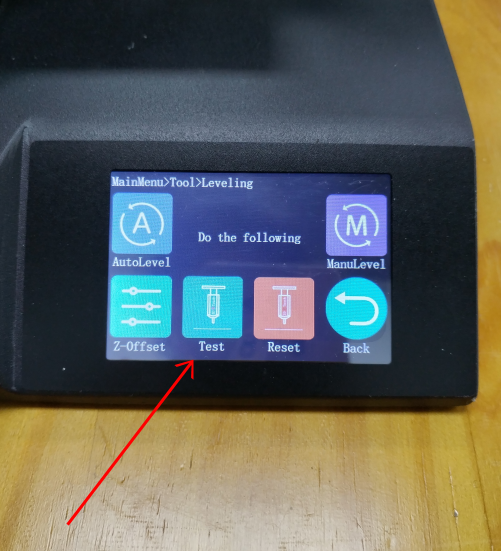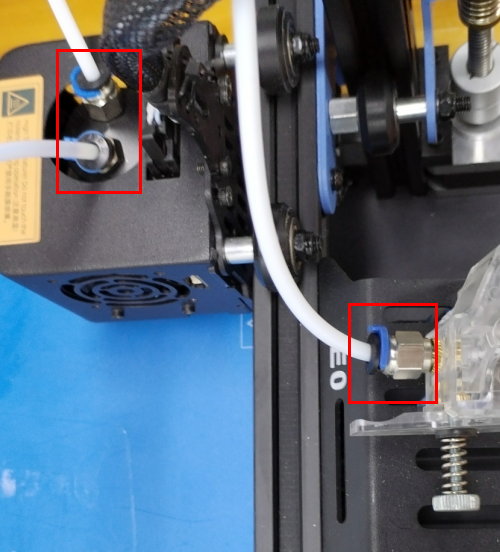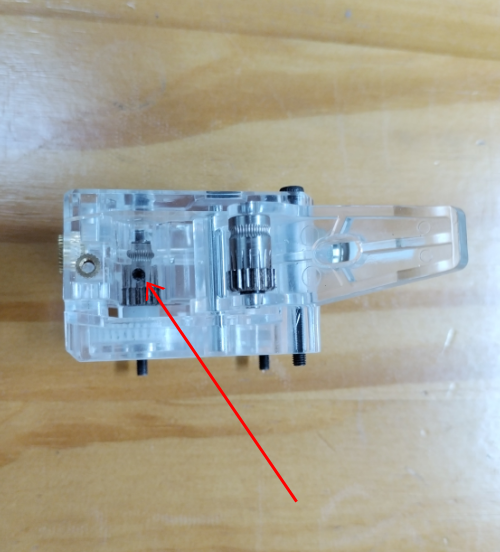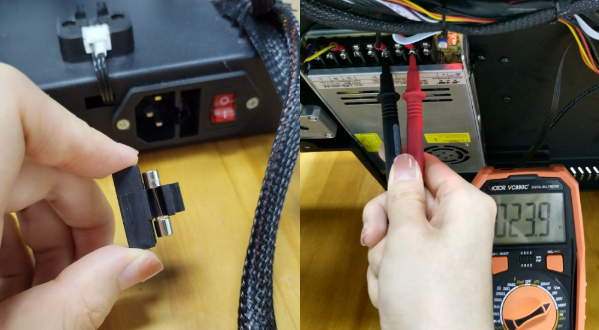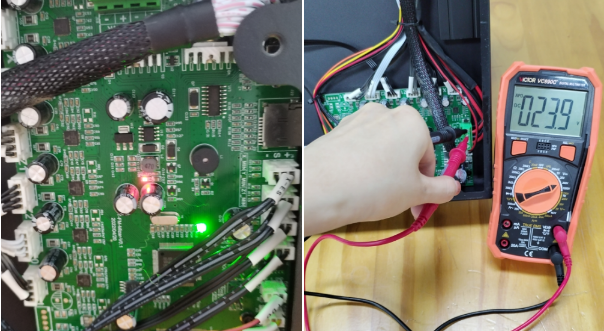Geeetech Mizar M 3D printer
Printer Introduction
Separate Mode VS Gradient Mode
Traditional monochrome printing has been difficult to meet the creative needs of 3D printing enthusiasts, and mixed-color printing has become the future trend. Mizar M has two print head modules, “Separated Color Module” and “Gradient Color Module”, and is designed for quick replacement in structure. After replacing the print head module and inserting the hot end connector, the system will intelligently identify the print head module and enter the corresponding print mode.
Unique Separated Color Module
Compared with Gradient Color Module, the Separated Color Module of Mizar M can realize printing a single color without mixing another color when printing models with two color filaments. Besides, it gains a faster printing speed, which can better meet the needs of two-color printing.
Patented gradient color technology
The Geeetech R&D team has optimized and upgraded Gradient Color Module of Mizar M. Compared with Geeetech’s first-generation multi-color 3D printer, the Mizar M Gradient Color Module has redesigned the color mixing flow channel and a structure to prevent the reverse flow of melting filament. The filament is more uniformly mixed in the hot end. This special design effectively solves the problem of uneven color mixing, and the hot end blocked due to the reverse flow of the melting filament. At present, the gradient color structure has applied for a patent.
Main specification
Technology: FDM
Printing Thickness: 0.1-0.2mm
Printing Materials: PLA,ABS, PETG
Printing Volume: 255*255*260mm
Auto-leveling: 3D Touch Leveling Sensor
Hotbed Heating Time(110℃): 11min
Nozzle Diameter: 0.4mm
Positional Accuracy: X axis: 0.011mm Y axis: 0.011mm Z axis: 0.0025mm
Printing Accuracy: ±0.1mm
Printing Speed: 20~150mm/S
Display: 3.5-inch Color Touch Screen
Hotbed Max Temperature: 110℃
Nozzle Max Temperature: 250℃
Working temperature: 10-40℃
Electric Parameter
Power Input: 115/230V AC, 50/60Hz
Power Supply: DC24V-15A Max, 350W
Mechanical Parameter
Hotbed Size: 260*260mm
Net Weight: 10.2kg
Gross Weight: 13kg
Machine Size: 400(W)*465(L)*484(H)mm
Package Size: 522(L)*482(W)*285(H)mm
Mizar M with a printing size of 255 x 255 x 260mm, supporting auto-leveling and manual leveling, is equipped with fixesd hotbed and 32-bit silent motherboard. Responding to two printing modes, it comes with double UI interaction systems. The machine comes with dual-drive gear extruder and double Z-axis ensuring high printing quality. At the same time, Mizar M are designed with belt adjustment kit, nozzle LED light, filament detector and break resuming capability, etc.
Watch the unboxing video and user manual before assembling the printer.
Printer Maintenance
How to slice with Cura
Trouble Shooting
Hotend clogging
Manually feed the filament, if it can not be extruded, try to disassemble the hotend to clean it. For the video tutorial, please refer to our video tutorials:
Clean up the Gradient Color Module of Geeetech Mizar M
Dismantle the Separate Color Module of Geeetech Mizar M
First preheat the nozzle to 220 degrees and then manually push the filament in the hotend to force the stuck filament in the nozzle out. For separate color module, you can use a cleaner rod to push it in and out several times, making the clogging out. Do not use excessive force.
But for the gradient color module, please do not use the metal rod, because it will destroy the little tube inside the hotend. If the clog can not be extruded, please try to disassemble the hotend.
Mintemp error
The Mintemp error in 3D printers is a design feature within your firmware for safety in regard to temperature. When below a set temperature, the heater will be switched off due to possibly having a broken thermistor wire. It can be observed a negative the temperature on the LCD screen.
Check if the hot end connector and thermistor are connected properly. Check the hotend cables and thermistor, make sure they’re not broken or burn out.
You can test the thermistor by a multimeter. If it fails to read the resistance, then the wire is broken. At room temperature, it should be 80 kΩ - 125 kΩ.
Or apply heat to the thermistor with a heater, blow-dryer or other heating device. The resistance should decline steadily in seconds if it works. If not, replace it.
Another common reason behind getting the MINTEMP error is from being in a cold environment, especially in winter months. Your 3D printer is designed to have a minimum temperature that it can operate in as a safety feature.
Filament sensor
The filament sensor will be worn out after long time use. We’ve uploaded a filament guide on our website to fix this.
And thanks to the 3D printer community, there’re lots of upgrade mods on the website for reference.
Mizar M filament guide by NoSssssweat
If there’s error on the screen prompts like “Change Filament” even filament has been uploaded, maybe the sensor is broken. You can test it by a multimeter.
Remember load a small piece of filament through the sensor before test. By touching each of the measurement leads of the multimeter to the two pins of the sensor, a signal (beep or 0 value on the multimeter screen) will indicate that the component is intact and therefore, should work.
Update Firmware
Download the latest firmware in our website
How to update:
1.Put "bin” file and "assets” folder in TF card root directory, insert TF card into the printer.
2.Turn on the printer, the screen will display the firmware upgrade progress bar.
3.After the progress is complete, the printer starts to upgrade UI.
4.Update is complete.
Notice:
1.After the upgrade, delete the bin file and assets folder in the TF card to prevent repeated upgrades.
2.Level the hotbed after the upgrade is complete.
Nothing is printing
(a)Nozzle is too close to the hotbed
Even though the extruder is working but no filament is depositing on the hotbed, Check if the nozzle is too close to the hotbed. Adjust the Z-offset value slightly will help.
(b)Print temperature is too low
Some filament needs more higher temperature, manually feed the filament, if it can not be extruded, please try increase the print temperature.
(c)The extruder is not working
Check if the grub screw on the extruder gear. If the grub screw is loose, the gears will fail to grab the filament when feeding into the hotend. Also check if the extruder motor is connected properly.
Automatic leveling failed
(a)3D Touch is abnormal
Check if the 3D Touch cables are connected properly. You can use the “Test” function to check if the 3D Touch is working normally.
(b)Homing failed
Check the X, Y and Z axes end stops, make sure they’re all connected properly. Note the photoelectric end stops on the Y and Z axes, which normally have a blue signal light. You can home the X, Y and Z axes one by one to check which axis is faulty.
(c)The first layer is messy
Please clean the hotbed before printing, this will help to get a good adhesion. We recommend a thicker first layer, 0.3 mm is good. If these’re not helpful, please try to adjust the Z-offset. What’s more, you can try adjust the hotbed temperature, for example, the Geeetech wood PLA needs a lower hotbed temperature but PETG needs higher.
Spring steel sheet problem
The spring steel sheet is flexible and easy for part removal. But keep in mind that prints are easy to remove after the plate cools down. Don’t try to forcefully remove the object when the sheet is still hot. We do not suggest you use the adhesive on the sheet, because the adhesive is difficult to clean up and may have an opposite effect.
If there’re leftover residue on the sheet, preheat the hotbed to 80 degrees to make the plastic soft. Then use the wet cloth wiping the plate and gently scrap the residue off.
A dirty bed will cause poor first layer adhesion. You need to remove the dirt, leftover residue or oil from the bed surface. Isopropyl alcohol (IPA) 90%+ will help to degrease the platform.
The extruder keeps making a noise
(a)Decrease the print speed. If the print speed is too fast, the extruder will push the filament too quickly. Filament may not have enough time to melt and even clog in the nozzle. A clogged nozzle will then exert pressure back on the extruder, resulting in clicking. For PLA, our recommended print speed is 60mm/s.
(b)Increase the print temperature. If the temperature is too low, it will not melt the filament properly. This can also clog the nozzle. As the extruder is no longer able to push the filament ahead, it starts “slipping”.
(c)Check the pneumatic fittings. A loose coupling could therefore allow molten filament to leak into a gap between the tube and the nozzle. This will restrict the flow of the filament, causing the extruder keep clicking.
(d)Change the extruder gear. After many hours of use, the teeth of the extruder may eventually wear out. Thus, it can no longer hold the filament, leading to filament slipping in the extruder.
(e)A low-tension extruder arm bar. If spring tension is too low, the extruder gear will not properly grip the filament. This leads to filament grinding.
(f)Check if the grub screw on the extruder gear. If the grub screw is loose, the gears will fail to grab the filament when feeding into the hotend.
Turn the printer on but the screen does not work
Warning: Never install or unplug anything on a printer while it’s being powered!
(a)Please check if the power supply is working normally. The red indicator on the switch should be light. And also check the fuse in the little black box, it should be complete without burns. Please measure the output voltage, which should be around 24 Volts.
(b)Please check if the control board is working normally. There’re one green LED and one red LED working as the picture shown below. Measure the input voltage of the control board, it should be around 24 Volts.
(c)Make sure the screen is connected properly.
